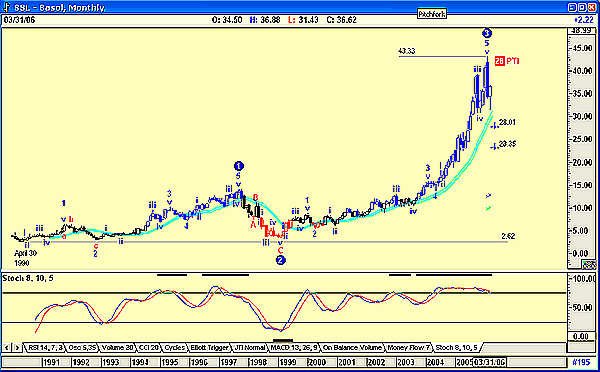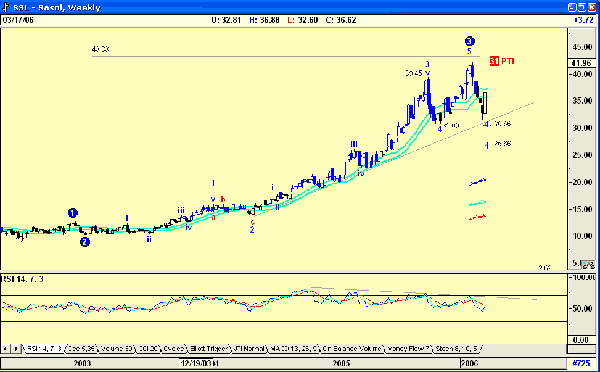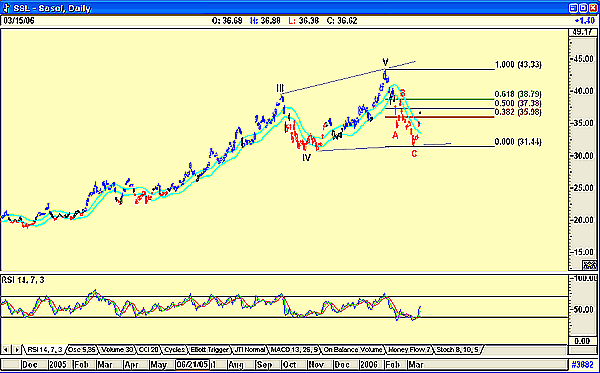
HOT TOPICS LIST
- MACD
- Fibonacci
- RSI
- Gann
- ADXR
- Stochastics
- Volume
- Triangles
- Futures
- Cycles
- Volatility
- ZIGZAG
- MESA
- Retracement
- Aroon
INDICATORS LIST
LIST OF TOPICS
PRINT THIS ARTICLE
by Koos van der Merwe
When South Africa was the target of world controversy because of its apartheid policies, SASOL was born out of necessity.
Position: Buy
Koos van der Merwe
Has been a technical analyst since 1969, and has worked as a futures and options trader with First Financial Futures in Johannesburg, South Africa.
PRINT THIS ARTICLE
ELLIOTT WAVE
SASOL
03/16/06 11:29:41 AMby Koos van der Merwe
When South Africa was the target of world controversy because of its apartheid policies, SASOL was born out of necessity.
Position: Buy
| The world only knows South Africa because of its diamonds and gold, but there are also very large coal mines. In the mid-1960s, SASOL (SSL) began to research the production of fuels from coal in response to South Africa's need for fuel in the face of the international embargo on the country as a result of the apartheid policy. The company began to produce ethylene and gasoline in the late 1960s, but its biggest breakthrough came in 1972, when the company succeeded in producing synthetic fuels. SASOL received a boost in 1973 when OPEC hiked oil prices around the world, causing an oil crisis. As a result of increased demand, SASOL opened two extra manufacturing facilities in the late 1970s. With the fall of the National Party and the coming to power of the African National Congress under Nelson Mandela, many believed that SASOL would be obsolete. At that point, oil flowed freely into the country. Gas prices fell, and many of the Arab states that had secretly supplied South Africa with oil happily showed their allegiance to the new regime by attending the inauguration of Nelson Mandela as president. |
| But in spite of the pessimism and a considerable drop in its share price, SASOL, by then considered a white elephant, survived. Too much had been spent in its development for it to be discarded. SASOL was unique, and although its process of converting coal to oil was more expensive than oil prices below $30 per barrel, research and development continued in an effort to refine the process and reduce the costs. Today, with oil prices at extremely high levels and with the Western world looking for alternative energy processes, SASOL has caught the attention of the United States and shrewd investors. Figure 1 shows how the company rose from a low of $2.62 on April 30, 1990, to its present high of $43.33. The chart also suggests a wave count showing that the share price could fall to $28.01 or $23.35 in a fourth wave if the price follows the pattern suggested. However, the PTI probability is only 28%. The relative strength index (RSI) is confirming the fall. |

|
| FIGURE 1: SASOL, MONTHLY. Here's how the price of this company's stock rose from a low of $2.62 in 1990 to its current $43.33. |
| Graphic provided by: AdvancedGET. |
| |
| The weekly chart in Figure 2 confirms the wave count, but suggests a fourth wave fall to $30.66, or $26.66. The probability of the wave count being correct is now 31%. With a low of $31.46 on March16, 2006, and the RSI now oversold and suggesting a buy, it is possible that investors could start accumulating the stock. |

|
| FIGURE 2: SASOL, WEEKLY. Here, the wave count is confirmed, but a fourth-wave fall is suggested as well. |
| Graphic provided by: AdvancedGET. |
| |
| When one looks at the daily chart (Figure 3), the wave count suggests that wave 5 has been completed; that waves A, B, and C could also have been completed, and that a new impulse wave upward could soon be starting. With the RSI suggesting a buy signal, this could be the trend for the future. |

|
| FIGURE 3: SASOL, DAILY. The wave count suggests that a new impulse wave could soon be starting. Could this be the trend for the future? |
| Graphic provided by: AdvancedGET. |
| |
| Of course, the price of the stock is dependent on the oil price, and with oil testing what could be lows at the moment, the price of SASOL could start rising once again. In Figure 3, I have suggested three Fibonacci levels, and the price could rise to complete a wave 1 of a five-impulse wave up. I also show a JM internal band (light blue). A JM internal band is a 15-period moving average offset by 2% and -2%. The price has moved upward on a gap, touching the upper band, a break above which would confirm a strong buy signal. Of course, SASOL has another perk, its technology. With oil prices rising and with the world looking for new technology to produce gas at reasonable prices, SASOL could start selling its technology to interested companies, or even collect royalties on its patents. Definitely a share worth considering. |
Has been a technical analyst since 1969, and has worked as a futures and options trader with First Financial Futures in Johannesburg, South Africa.
| Address: | 3256 West 24th Ave |
| Vancouver, BC | |
| Phone # for sales: | 6042634214 |
| E-mail address: | petroosp@gmail.com |
Click here for more information about our publications!
Comments
Date: 03/18/06Rank: 3Comment:

|

Request Information From Our Sponsors
- StockCharts.com, Inc.
- Candle Patterns
- Candlestick Charting Explained
- Intermarket Technical Analysis
- John Murphy on Chart Analysis
- John Murphy's Chart Pattern Recognition
- John Murphy's Market Message
- MurphyExplainsMarketAnalysis-Intermarket Analysis
- MurphyExplainsMarketAnalysis-Visual Analysis
- StockCharts.com
- Technical Analysis of the Financial Markets
- The Visual Investor
- VectorVest, Inc.
- Executive Premier Workshop
- One-Day Options Course
- OptionsPro
- Retirement Income Workshop
- Sure-Fire Trading Systems (VectorVest, Inc.)
- Trading as a Business Workshop
- VectorVest 7 EOD
- VectorVest 7 RealTime/IntraDay
- VectorVest AutoTester
- VectorVest Educational Services
- VectorVest OnLine
- VectorVest Options Analyzer
- VectorVest ProGraphics v6.0
- VectorVest ProTrader 7
- VectorVest RealTime Derby Tool
- VectorVest Simulator
- VectorVest Variator
- VectorVest Watchdog
